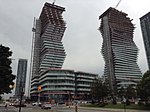Mississauga City Centre Transit Terminal

The City Centre Transit Terminal in Mississauga, Ontario, Canada is the main transit hub and bus station for MiWay, the city's public transit system. The station is situated in Mississauga City Centre at the northwest corner of Square One Shopping Centre, and buses using the terminal display "Square One" on their destination signs. Buses use the upper level, while access from the mall is on lower ground via crosswalk (no direct connection), where a taxi stand and kiss and ride are located. Services provided on the upper level of the building include ticket sales, information booth, and lost and found, while washroom facilities and MiWay transit police holding cells is located on the lower level. The terminal is accessible by both elevator and escalator. GO Transit's regional Square One Bus Terminal is located directly north, across Rathburn Road, on Station Gate Road.
Excerpt from the Wikipedia article Mississauga City Centre Transit Terminal (License: CC BY-SA 3.0, Authors, Images).Mississauga City Centre Transit Terminal
Rathburn Road West, Mississauga
Geographical coordinates (GPS) Address Nearby Places Show on map
Geographical coordinates (GPS)
| Latitude | Longitude |
|---|---|
| N 43.593888888889 ° | E -79.646555555556 ° |
Address
Rathburn Road West
L5B 3C1 Mississauga
Ontario, Canada
Open on Google Maps









